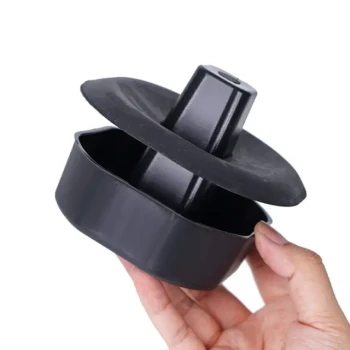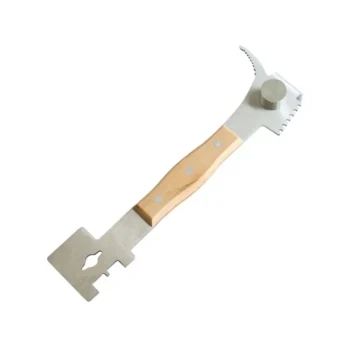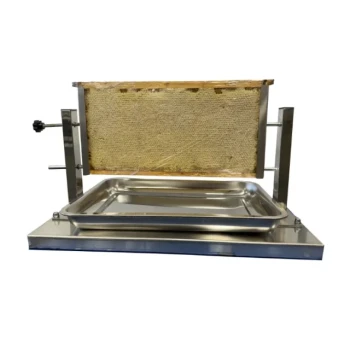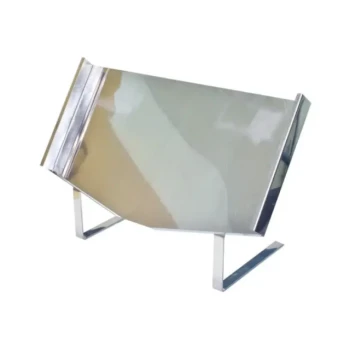At its core, a beehive stand is a simple, high-impact tool that improves colony health and beekeeper ergonomics. It elevates the hive off the ground, which reduces the need for you to bend when lifting heavy boxes, protects the hive from ground moisture that can cause rot and disease, and creates a crucial barrier against common pests and predators.
A beehive stand isn't just about convenience; it's the foundation of a proactive hive management strategy. By elevating the colony, you are fundamentally improving its defensibility against environmental threats like moisture and pests, while making the physically demanding work of beekeeping far more sustainable.
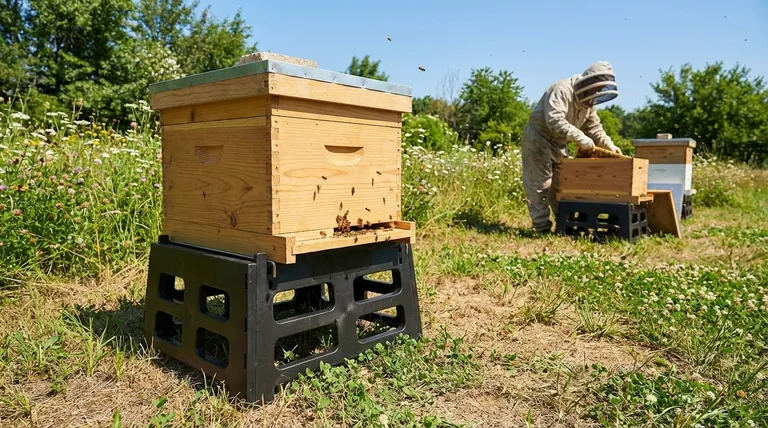
Protecting the Health of the Colony
A beehive stand’s primary function is to create a more stable and protected environment for your bees. It directly addresses the most common threats that originate from ground level.
Fighting Moisture and Rot
Placing a hive directly on the ground exposes the bottom board to constant moisture. This moisture wicks up into the wood, promoting the growth of mold and mildew and accelerating rot.
A damp hive interior is a serious threat to a colony, especially during winter. It makes thermoregulation difficult and can lead to chilled brood. An elevated hive with an air gap underneath stays significantly drier, extending the life of your equipment and creating a healthier internal environment.
Deterring Pests and Predators
Elevation is a simple but effective form of pest control. Many hive predators, like skunks and raccoons, are deterred when they cannot easily reach the entrance. A stand forces them into a more vulnerable position to access the hive.
It also makes it more difficult for crawling insects like ants to establish a trail into the hive. While not a complete solution, a stand is a critical first line of defense that disrupts easy access for many unwanted visitors.
Improving Air Circulation
Lifting a hive off the ground creates an insulating pocket of air. This prevents the cold, damp ground from acting as a heat sink, constantly pulling warmth from the cluster during winter.
This same air gap improves ventilation during the summer, helping to prevent the hive from overheating. Good circulation under the hive complements other ventilation strategies, like using an inner cover or a ventilated top cover.
Enhancing the Beekeeper's Experience
Beyond benefits to the bees, a stand makes the physical work of beekeeping safer and more efficient.
Reducing Physical Strain
A standard Langstroth hive box filled with honey can easily weigh 80 pounds or more. Repeatedly lifting these boxes from ground level is a direct cause of back strain and injury.
A stand raises the hive to a more ergonomic height, between your knees and waist. This allows you to lift with your legs, not your back, dramatically reducing the physical toll of inspections and honey harvesting. It achieves the same back-saving goal sought by users of single-level horizontal hives.
Simplifying Hive Inspections
Working on a hive that is 12 to 18 inches off the ground means less kneeling and bending. This makes inspections faster, more comfortable, and more thorough.
Furthermore, an elevated hive entrance is less likely to be blocked by overgrown grass, weeds, or heavy snow, ensuring bees have a clear flight path.
Understanding the Trade-offs and Considerations
While highly beneficial, implementing a hive stand requires careful thought to avoid creating new problems.
Hive Stability is Paramount
Raising a hive also raises its center of gravity, making it more susceptible to tipping in high winds or if knocked. Your stand must be placed on firm, level ground.
Ensure the stand itself is sturdy, wide, and will not rock. A tipped hive is a catastrophic event for the colony and a major setback for the beekeeper.
Finding the Right Height
There is a trade-off with height. While a higher stand is better for your back when inspecting lower boxes, an overly tall stand can make it difficult to lift heavy honey supers onto the very top of the hive stack.
A height of 12 to 18 inches is generally considered the ideal compromise. This provides sufficient ground clearance for protection while keeping the top of the hive at a manageable working height.
Material Choice Matters
Common materials for stands include wood, metal, and cinder blocks. Cinder blocks are inexpensive and durable but their holes can become homes for pests like ants or mice if not filled or screened. Wood is a classic choice but will rot if not properly treated or maintained. Metal stands are often the most durable but also the most expensive.
Making the Right Choice for Your Apiary
A stand is an essential piece of equipment, but the best choice depends on your specific goals.
- If your primary focus is colony health: Choose a stand that provides at least 12-18 inches of elevation to maximize protection from ground moisture and common pests.
- If your primary focus is personal ergonomics: Select a stand height that brings the hive's heaviest boxes into your "power zone"—the area between your mid-thigh and mid-chest.
- If your primary focus is budget and simplicity: Simple, level cinder blocks are a highly effective and low-cost starting point, but remain vigilant about pests nesting within them.
Ultimately, elevating your hive with a stand is a foundational decision that pays dividends in colony vitality, equipment longevity, and your own physical well-being as a beekeeper.
Summary Table:
| Benefit Category | Key Advantages |
|---|---|
| Colony Health | Protects from ground moisture & rot, deters pests (ants, skunks), improves ventilation. |
| Beekeeper Ergonomics | Reduces physical strain & back injury, simplifies hive inspections, improves workflow. |
| Hive Management | Extends equipment life, provides a stable foundation, prevents entrance blockages. |
Ready to build a stronger, more productive apiary?
A sturdy beehive stand is the foundation of a healthy, manageable hive. For commercial apiaries and beekeeping equipment distributors, the right equipment is not a luxury—it's a necessity for protecting your investment and ensuring operator safety.
HONESTBEE supplies durable, commercial-grade beehive stands and a full range of beekeeping supplies designed for high-volume operations. We help you work smarter, not harder.
Contact HONESTBEE today to discuss your wholesale needs and discover how our equipment can support your success.
Visual Guide
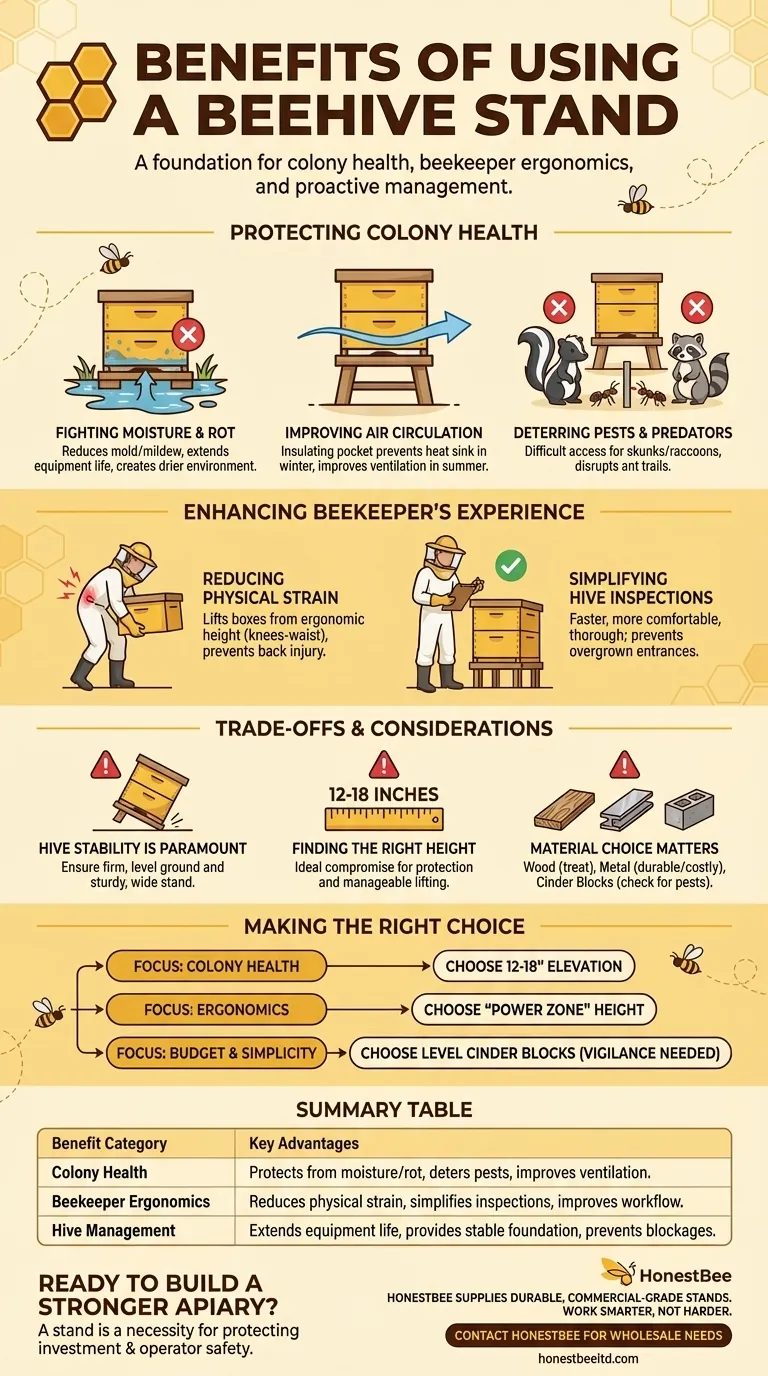
Related Products
- Plastic Bee Hive Stand for Beekeeping
- Metal Hive Feet Bee Hive Stand for Ant Protection
- Metal Bee Hive Stand Bee Box Stand for Beekeeping
- Wholesales Dadant Size Wooden Bee Hives for Beekeeping
- Professional Drop-Style Hive Handles for Beekeeping
People Also Ask
- How does the longevity of plastic bee hives compare to wooden hives? Discover the Durable Choice
- What are the main differences between Langstroth and Top Bar Hive designs? Choose the Right Hive for Your Beekeeping Goals
- How do bees regulate ventilation and temperature in the hive? Master Hive Climate Control
- How do plastic bee hives compare to wooden hives in handling? Reduce Strain & Boost Efficiency
- Why is it important to level a hive stand properly? Prevent Catastrophic Failure & Ensure Hive Health





